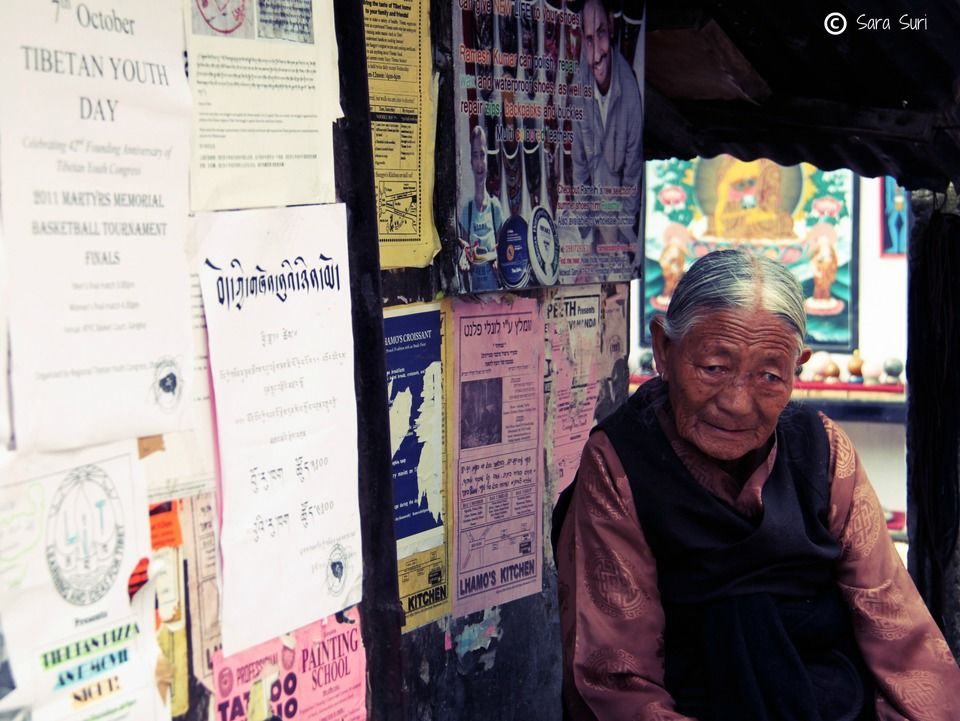It took her over a month of travelling undercover to reach India. She cowered hidden in trucks, walked for days in the snow, climbed high passes on foot, crossed gushing rapids and conquered bone-chilling rivers; all the while dodging the attention of Chinese border guards. She was then 11 years old.

This is not just her story. This is the story of every Tibetan refugee.
The Temple in the Clouds
Prayer bells are humming through the streets of Mcleodganj, just like every morning. I walk through the mist floating in the chilly February air, with a handwoven scarf wrapped around my chin. Smiling faces look up at me, momentarily distracted from their early morning routine. Lines of multicoloured pennants flutter in a distance, swaying with the symphony of the wind. The lady who makes my favourite momos is not here yet.

I walk past a woman older than the road she's walking on, her face defined by the lines that resemble the undulating landscape of the mountains that are her home. Meditating with beads in her hand, she's clearly inching towards the trail that encircles the temple of the 14th Dalai Lama.

"A simple Buddhist monk"
Mcleodganj is 10 kilometres above Dharamsala, on the other end of a steep winding road riddled with tight hairpin bends. The multicoloured prayer flags that decorate the mountains above the town, symbolise the transformation of Dharamsala to Dhasa, or Little Lhasa, which today is home to thousands of Tibetan refugees, including the Dalai Lama.

Beloved and respected around the world, the Dalai Lama has been banned in Tibet for half a century. This includes a ban on his teachings, his picture and even his name. For a culture so steeped in spiritualistic traditions, the censorship imposed on the unequivocal leader of Tibetan Buddhism meant that following him to India became an inevitability.
He calls himself a "simple Buddhist monk", but the Dalai Lama personifies the essence of an entire culture's identity, the politics of which are on showcase in Little Lhasa.

The Politics of Identity
It was a cold evening and I warmed my hands around a cup of tea. I looked outside the cafe from my window seat as the street was overtaken by a sea of maroon robes. Monks lined up in a queue with a candle in their hands. As the line moved slowly and quietly along, the streets were drowned in a wave of silence. I later learnt that they were paying tribute to a fellow monk in Tibet, who had lost his life earlier that day when he immolated himself in protest in Lhasa, Tibet.

"Free Tibet" is the universal mantra, plastered on flags and as art in a community in consensus. The revival of identity in the streets of Upper Dharamsala is vigorous and complete. "Nothing here is made in China", proclaims a shop window selling souvenirs and local art.

A hotbed of activism, environmentalism and learning, Mcleodganj is much more than an increasingly trendy tourist destination. The streets teem with yogis, monks and Buddhist scholars. Polyglots and spiritualists wander the streets, mingling with strangers in the rainbow explosion of human diversity. Children grow up speaking multiple foreign languages, including Tibetan. Even while tucked within this vibrant mix of cultures, Mcleodganj is distinctly Tibetan.

Just off the main square, as the road disperses from commotion of the main square to pedestrian tranquility, there's a cafe called Common Ground. Created with the mission of encouraging conversations, particularly among Chinese tourists and Tibetans, the cafe embodies the spirit of millennial Tibetan identity.
"I still dream of Lhasa", said a man who wound up in the cafe, years after he escaped Tibet as a teenager. Since then, he has been to five countries, lived in France for a year and is now studying to be a monk. I glanced at the beaded bracelet on his wrists. It spelled "Save Tibet". His family still lives in Tibet. I sincerely hoped that he would see them again.

I was sitting on my favourite bench when the meditating woman I had seen earlier, walked past me, steady and pensive. She continued along and disappeared behind the bend. As I looked up at the hundreds of prayer flags fluttering in the wind, I wondered what her story was.
Over a hundred thousand Tibetan refugees live in India. Read about the history of the Tibetan Independence Movement and the sovereignty debate.
Tripoto is a global community for travellers and a great platform for travel writers. Been anywhere great recently? Share your travelogues on Tripoto and showcase your trips to millions of people around the world.























